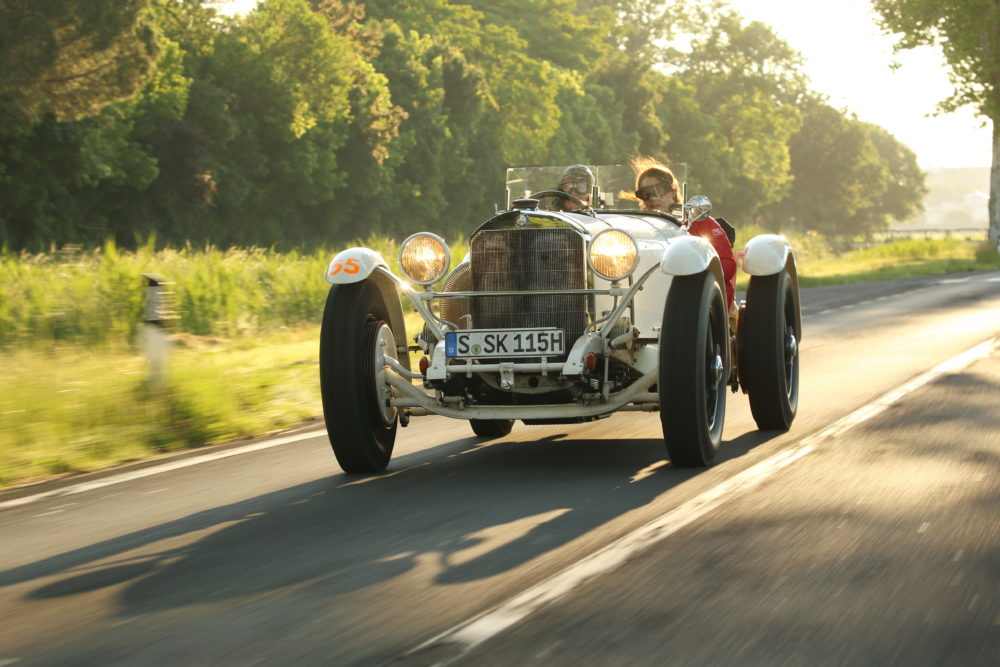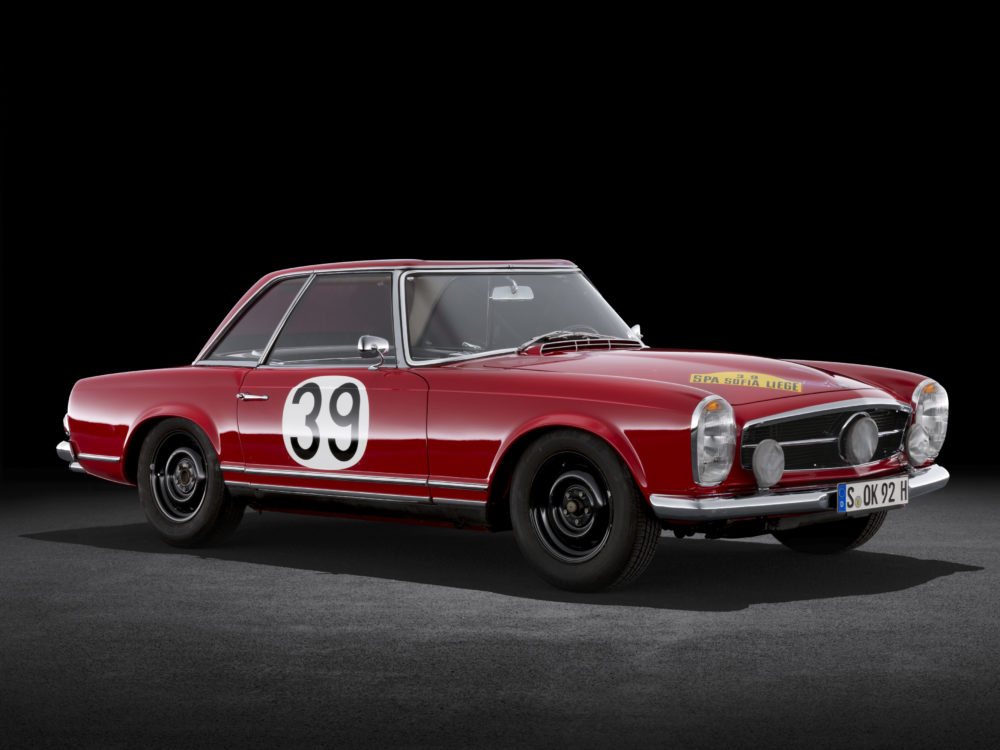Mercedes to Bring ’60 Years’ of Benzes to Swiss Rally, July 5

Mercedes-Benz SSK (W 06, 1928 to 1932)
Of the high-performance sports cars of the Mercedes-Benz S-series launched in 1927, the SSK (W 06) was the most exclusive and fascinating model. The model designation of this supercharged car with a 7.1-liter six-cylinder engine stood for Super-Sport-Kurz (Super Sport Short) and featured a shorter wheelbase alongside its particular sportiness. Following numerous victories achieved by the Model S as the first model in the series, the succeeding SS and SSK models continued the success story. In the summer of 1928, works racing driver Rudolf Caracciola won the Gabelbach Race on the first attempt as well as the races to the top of the Schauinsland Mountain and the Mont Ventoux with the brand-new SSK.
In 1930, he won the European hill racing championship driving an SSK. In the same year, the supercharged sports car also took part in the 1000 Miglia for the first time. Caracciola and Christian Werner took sixth place in the overall classification in a time of 17 hours and 20 minutes. With reduced weight and another power increase to 220 kW (300 hp), the 1931 version, also known as the SSKL (Super Sport Short Light), achieved a spectacular success in the 1000 Miglia. In April 1931, Caracciola was the first non-Italian to win this demanding road race from Brescia to Rome and back – in a new record time of 16 hours and 10 minutes.
Technical data Mercedes-Benz SSK (production version)
Production period: 1928 to 1932
Cylinders: 6/in-line
Displacement: 7,065 cc
Output: 125 kW (170 hp), with supercharger 165 kW (225 hp)
Top speed: 192 km/h

Mercedes-Benz 300 SL ‘Gullwing’ (W 198, 1954 to 1957)
In February 1954, the 300 SL standard-production sports car (W 198) celebrated its world première at the International Motor Sport Show in New York. The coupé was called the “Gullwing” or the “Papillon” (butterfly) owing to its distinctive roof-mounted doors, which resembled a gull’s wings. The high-performance sports car was based on the legendary 300 SL racing car (W 194) from the 1952 season. It was the first standard-production car with a four-stroke petrol injection engine.
With an engine output of 158 kW (215 hp) – a good 25 percent more than the carburetor motor racing version of 1952 – and a top speed of up to 250 km/h, the W 198 was in the top echelon of production sports cars in its day, which also predestined it for racing. One legendary triumph was the triple class victory of the 300 SL “Gullwing” in the 1955 1000 Miglia. John Cooper Fitch and his co-driver Kurt Gessl won fifth place in the overall classification in the car bearing race number 417, which represented their starting time at 4:17 am, and led the class of production sports cars over 1.3-liter displacement ahead of two more “Gullwings.” Between 1954 and 1957, a total of 1,400 vehicles of the 300 SL “ Gullwing” were built, no fewer than 867 of them in the year of its 1000 Miglia class victory in 1955.
Technical data Mercedes-Benz 300 SL “Gullwing”
Production period: 1954 to 1957
Cylinders: 6/inline
Displacement: 2,996 cc
Output: 158 kW (215 hp)
Top speed: Up to 250 km/h

Mercedes-Benz 190 SL (W 121, 1955 to 1963)
Together with the 300 SL “Gullwing” high-performance sports car, Mercedes-Benz in February 1954 unveiled the prototype of the elegant, compact 190 SL (W 121) roadster. The open-top two-door model was designed as a sporty, elegant touring and utility vehicle for two persons and, especially in the revised standard-production vehicle, was closely based on its “big brother,” the 300 SL, on the stylistic front. Designed from the outset as a roadster, the 190 SL established the tradition of SL sports cars with a roof that could be opened.
The roadster, for its part, was more closely related at a technical level to the Mercedes-Benz 180 “Ponton” Saloon (W 120), copying the latter’s shortened floor assembly. The 1.9-liter gas engine rated at 77 kW (105 hp) was newly developed. The four-cylinder engine featured an overhead camshaft and became the forefather of an entire family of engines. For outings on the track, there was a racing version with windowless aluminium doors, a smaller windscreen and other modifications. A 190 SL (start number 347) also competed in the 1956 1000 Miglia. All in all, 25,881 vehicles of this model were built between 1955 and 1963, with some 10,000 of them going to the USA.
Technical data Mercedes-Benz 190 SL (production version)
Production period: 1955 to 1963
Cylinders: 4/inline
Displacement: 1,897 cc
Output: 77 kW (105 hp)
Top speed: 171 km/h

Mercedes-Benz 230 SL rally vehicle (W 113, 1963 to 1967)
The 230 SL made its debut at the Geneva Motor Show in March 1963. It replaced two models from the previous sales range: the 300 SL “Gullwing” super sports car (W 198) and the elegant 190 SL touring car (W 121). Known internally as W 113, the 230 SL maintained the balance between the principles of its predecessors as a comfortable, two-seater touring car, offering high performance along with optimal driving safety. The 230 SL was a trailblazer, being, among other things, the first Mercedes-Benz sports car to feature the safety body developed by Béla Barényi (rigid passenger cell with deformable front and rear sections).
The removable coupé roof was of concave design, and this avant-garde feature made the roof especially strong along with a lightweight construction. And, as a characteristic design attribute, it earned the model series the nickname “Pagoda.” Heavily based on the production car, versions of the 230 SL were successful in motor sport. For example, Böhringer, driving a rally version of the model, was victorious in the long-distance Spa–Sofia–Liège Rally of 1963. The 250 SL of the W 113 model series replaced the 230 SL in 1967. It, in turn, was replaced in 1968 by the 280 SL (W 113).
Technical data Mercedes-Benz 230 SL (production version)
Production period: 1963 to 1967
Cylinders: 6/in-line
Displacement: 2,306 cc
Output: 110 kW (150 hp)
Top speed: 200 km/h
Continued…
